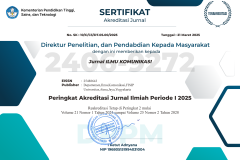Spiral Keheningan Melalui Tagar #indonesiaterserah Jelang Idul Fitri 2020
DOI:
https://doi.org/10.24002/jik.v19i1.3759Keywords:
spiral keheningan, penanda sosial, naratif, Idul FitriAbstract
Tagar #indonesiaterserah adalah gelembung suara minoritas pekerja kesehatan di Indonesia jelang Idul Fitri 2020. Penelitian tradisi naratif dengan metode kualitatif ini mengumpulkan percakapan di Twitter selama 15 hari dari tanggal 10–25 Mei 2020. Sejumlah 8.144 (65 persen) dari 12.553 akun bernarasi negatif. Pergerakan sentimen negatif merupakan dampak pemberitaan media siber di Indonesia dengan 200 juta keterlibatan akun pengguna. Narasi dibedah dengan teori spiral keheningan. Hasil penelitian menunjukkan resonansi sosial opini minoritas menemukan bentuk barunya dalam media sosial. Opini yang bergerak pada spiral menjadi isu utama yang bertahan lebih dari 10 hari jelang perayaan Idul Fitri.
References
Alexa. (2017). Top Sites in Indonesia. Retrieved May 21, 2020, from https://www.alexa.com/topsites/countries/ID
Awazu, M., Barakat, A. Y., Chevaller, R. L., & Ichikawa, I. (1989). The cause of uremia in obstructed kidneys. The Journal of Pediatrics (Vol. 114). https://doi.org/10.1016/S0022-3476(89)80781-4
Batsell, J. (2015). Engaged journalism: connecting with digitally empowered news audiences. Choice Reviews Online (Vol. 52). https://doi.org/10.5860/choice.191140
Carrington, P. J., Scott, J., & Wasserman, S. (Eds.). (2005). Models and Methods in Social Network Analysis. New York: Cambridge University Press.
Chen, L. J., Cai, S. M., Zhang, Q. M., Zhou, T., & Zhang, Y. C. (2019). Improved Research on Resource-Allocation Recommendation Algorithm Based on Trust Relationship. Dianzi Keji Daxue Xuebao/Journal of the University of Electronic Science and Technology of China, 48(3), 449–455. https://doi.org/10.3969/j.issn.1001-0548.2019.03.022
Cho, J., Ahmed, S., Keum, H., Choi, Y. J., & Lee, J. H. (2018). Influencing Myself: Self-Reinforcement Through Online Political Expression. Communication Research, 45(1), 83–111. https://doi.org/10.1177/0093650216644020
Coleman, R., McCombs, M., Shaw, D., & Weaver, D. (2009). The Handbook of Journalism Studies Chapter 11: Agenda Setting. The Handbook of Journalism Studies. https://doi.org/10.3109/02699206.2011.557176
Denzin, N. K., & Lincoln, Y. S. (2009). Handbook Of Qualitative Research. Sage Publication, Inc.
Detiknews. (2020). Kapan Sebenarnya Corona Pertama Kali Masuk RI? Retrieved from https://news.detik.com/berita/d-4991485/kapan-sebenarnya-corona-pertama-kali-masuk-ri?single=1
Dvir-Gvirsman, S., Garrett, R. K., & Tsfati, Y. (2018). Why Do Partisan Audiences Participate? Perceived Public Opinion as the Mediating Mechanism. Communication Research, 45(1), 112–136. https://doi.org/10.1177/0093650215593145
Frank, O. (2012). Network Sampling and Model Fitting. In P. J. Carrington, J. Scott, & S. Wasserman (Eds.), Models and Methods in Social Network Analysis (pp. 31–56). New York: Cambridge University Press. https://doi.org/10.1017/cbo9780511811395.003
Frank, P., & Watchravesringkan, K. (Tu). (2016). Exploring antecedents and consequences of young consumers’ perceived global brand equity. Journal of Product and Brand Management, 25(2), 160–170. https://doi.org/10.1108/JPBM-01-2015-0786
Holmes, D. (2005). Communication Theory Media, Technology and Society. Sage Publication, Inc.
Kaya, M., Kawash, J., Khoury, S., & Day, M.-Y. (Eds.). (2018). Social Network Based Big Data Analysis and Applications. Cham, Switzerland: Springer.
Kementrian Kesehatan RI. Peraturan Menteri Kesehatan No. 9 Tahun 2020 Tentang Pedoman Pembatasan Sosial Berskala Besar Dalam Rangka Percepatan Penanganan Corona Virus Disease 2019 (COVID-19), Kementrian Kesehatan Republik Indonesia § (2020). https://doi.org/10.1017/CBO9781107415324.004
Knobloch-Westerwick, S., & Johnson, B. K. (2014). Selective Exposure for Better or Worse: Its Mediating Role for Online News’ Impact on Political Participation. Journal of Computer-Mediated Communication, 19(2), 184–196. https://doi.org/10.1111/jcc4.12036
Kopp, S. (2010). Social resonance and embodied coordination in face-to-face conversation with artificial interlocutors. Speech Communication, 52(6), 587–597. https://doi.org/10.1016/j.specom.2010.02.007
Kristian, E. (2020). Fakta Lengkap Kasus Pertama Virus Corona di Indonesia. Kompas.Com. Retrieved from https://nasional.kompas.com/read/2020/03/03/06314981/fakta-lengkap-kasus-pertama-virus-corona-di-indonesia
Littlejhon, S. W., & Foss, K. A. (2009). Teori Komunikasi Edisi 9 (Terjemahan). Jakarta: Salemba Humanika.
Littlejhon, S. W., & Foss, K. A. (2016). Ensiklopedia Teori Komunikasi (Terjemahan). Jakarta: Kencana.
Nasrullah, R. (2015). Media Sosial. Perspektif Komunikasi, Budaya, dan Sosioteknologi. Bandung: Remaja Rosdakarya.
Neuwirth, K., Frederick, E., & Mayo, C. (2007). The spiral of silence and fear of isolation. Journal of Communication, 57(3), 450–468. https://doi.org/10.1111/j.1460-2466.2007.00352.x
Noelle‐Neumann, E. (1974). The Spiral of Silence A Theory of Public Opinion. Journal of Communication, 24(2), 43–51. https://doi.org/10.1111/j.1460-2466.1974.tb00367.x
Scott, J. (2000). Social Network Analysis: A Handbook. (Second). London: Sage.
Setiawan, H. (2019). Memiilih Diantara 7 Tradisi Ilmu Komunikasi Dalam Kerangka Filosofis. Jurnal Darussalam: Jurnal Pendidikan, Komunikasi Dan Pemikiran Hukum Islam, 11(1), 18. https://doi.org/10.30739/darussalam.v11i1.447
Sohn, D. (2019). Spiral of Silence in the Social Media Era: A Simulation Approach to the Interplay Between Social Networks and Mass Media. Communication Research, 009365021985651. https://doi.org/10.1177/0093650219856510
Visser, P. S., & Mirabile, R. R. (2004). Attitudes in the social context: The impact of social network composition on individual-level attitude strength. Journal of Personality and Social Psychology, 87(6), 779–795. https://doi.org/10.1037/0022-3514.87.6.779
Wright, C., & Madrid, G. (2007). Contesting ethical trade in Colombia’s cut-flower industry: A case of cultural and economic injustice. Cultural Sociology (Vol. 1). https://doi.org/10.1177/1749975507078190
Ytreberg, E. (2004). Formatting participation within broadcast media production. Media, Culture and Society, 26(5), 677-692+714. https://doi.org/10.1177/0163443704045506
Downloads
Published
How to Cite
Issue
Section
License
Copyright (c) 2022 Jurnal ILMU KOMUNIKASI

This work is licensed under a Creative Commons Attribution 4.0 International License.
Jurnal ILMU KOMUNIKASI is an academic journal. As such, it is dedicated to the open exchange of information. For this reason, JIK is freely available to individuals and institutions. Authors who publish in Jurnal ILMU KOMUNIKASI will release their articles under the Creative Commons Attribution (BY) License. This license allows anyone to copy and redistribute the article in any medium or format as well as remix, transform, and build upon the material for any purpose, even commercially as long as they credit the authors for the original creation. For details of the rights authors grants users of their work, see the "human-readable summary" of the license, with a link to the full license. (Note that "you" refers to a user, not an author, in the summary)
 This work is licensed under a Creative Commons Attribution 4.0 International License.
This work is licensed under a Creative Commons Attribution 4.0 International License.














